#First Android-Based Spatial Computer
Explore tagged Tumblr posts
Text
Play For Dream Technology Launches World’s First Android-Based Spatial Computer in Singapore
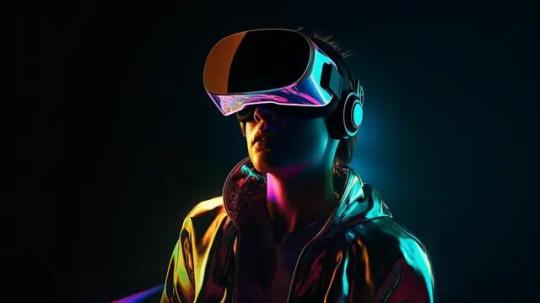
On June 25, 2024, Play For Dream Technology, a Shanghai-based leader in spatial entertainment technology, made a significant leap forward by launching the world’s first Android-based spatial computer, Play for Dream MR, in Singapore. This launch marks the company’s first international expansion, with Singapore now serving as its Asia-Pacific marketing headquarters. The global event attracted key media representatives, investors, and stakeholders from across the region, highlighting Play For Dream’s ambitious vision to redefine spatial computing on a global scale.
The Play for Dream MR is a groundbreaking mixed reality (MR) headset that sets new standards in spatial entertainment. It offers a rich array of advanced features, including IMAX-level movie experiences, eight DTS-customised spatial sound effects, immersive MR gaming, and the ability to record and photograph in stunning 3D spatial formats. With industry-leading specifications and a powerful self-developed algorithm architecture, the device seamlessly integrates digital and real-world environments, delivering an unmatched entertainment experience that pushes the boundaries of what is possible in mixed reality.
Read More: (https://theleadersglobe.com/science-technology/play-for-dream-technology-launches-worlds-first-android-based-spatial-computer-in-singapore/)
#Dream Technology Launches#First Android-Based Spatial Computer#algorithm architecture#global leader magazine#the leaders globe magazine#leadership magazine#world's leader magazine#article#best publication in the world#news#magazine#business
1 note
·
View note
Text
Yandere! Android x Reader (I)


It is the future and you have been tasked to solve a mysterious murder that could jeopardize political ties. Your assigned partner is the newest android model meant to assimilate human customs. You must keep his identity a secret and teach him the ways of earthlings, although his curiosity seems to be reaching inappropriate extents.
Yes, this is based on Asimov’s “Caves of Steel” because Daneel Olivaw was my first ever robot crush. I also wanted a protagonist that embraces technology. :)
Content: female reader, AI yandere, 50's futurism
[Part 2] | [More original works]

You follow after the little assistant robot, a rudimentary machine invested with basic dialogue and spatial navigation. It had caused quite the ruckus when first introduced. One intern - well liked despite being somewhat clumsy at his job - was sadly let go as a result. Not even the Police is safe from the threat of AI, is what they chanted outside the premises.
"The Commissioner has summoned you, (Y/N)."
That's how it greeted you earlier, clacking its appendage against the open door in an attempt to simulate a knock.
"Do you know why my presence is needed?" You inquire and wait for the miniature AI to scan the audio message.
"I am not allowed to mention anything right now." It finally responds after agonizing seconds.
It's an alright performance. You might've been more impressed by it, had you not witnessed first hand the Spacer technology that could put any modern invention here on Earth to shame. Sadly the people down here are very much against artificial intelligence. There have been multiple protests recently, like the one in front of your building, condemning the latest government suggestion regarding automation. People fear for their jobs and safety and you don't necessarily blame them for having self preservation. On the other hand, you've always been a supporter of progress. As a child you devoured any science fiction book you could get your hands on, and now, as a high ranked police detective you still manage to sneak away and scan over articles and news involving the race for a most efficient computer.
You close the door behind you and the Commissioner puts his fat cigarette out, twisting the remains into the ashtray with monotonous movements as if searching for the right words.
"There's been a murder." Is all he settles on saying, throwing a heavy folder in your direction. A hologram or tablet might've been easier to catch, but the man, like many of his coworkers, shares a deep nostalgia for the old days.
You flip through the pages and eventually furrow your eyebrows.
"This would be a disaster if it made it to the news." You mumble and look up at the older man. "Shouldn't this go to someone more experienced?"
He twiddles with his grey mustache and glances out the fake window.
"It's a sensitive case. The Spacers are sending their own agent to collaborate with us. What stands out to you?"
You narrow your eyes and focus on the personnel sheet. What's there to cause such controversy? Right before giving up, departing from the page, you finally notice it: next to the Spacer officer's name, printed clearly in black ink, is a little "R." which is a commonly used abbreviation to indicate something is a robot. The chief must've noticed your startled reaction and continues, satisfied:
"You understand, yes? They're sending an android. Supposedly it replicates a human perfectly in terms of appearance, but it does not possess enough observational data. Their request is that whoever partners up with him will also house him and let him follow along for the entirety of the mission. You're the only one here openly supporting those tin boxes. I can't possibly ask one of your higher ups, men with wives and children, to...you know...bring that thing in their house."
You're still not sure whether to be offended by the fact that your comfort seems to be of less priority compared to other officers. Regardless of the semantics, you're presently standing at the border between Earth and the Spacer colony, awaiting your case partner. A man emerges from behind a security gate. He's tall, with handsome features and an elegant walk. He approaches you and you reach for a handshake.
"Is the android with you?" You ask, a little confused.
"Is this your first time seeing a Spacer model?" He responds, relaxed. "I am the agent in your care. There is no one else."
You take a moment to process the information, similar to the primitive machine back at your office. Could it be? You've always known that Spacer technology is years ahead, but this surpasses your wildest dreams. There is not a single detail hinting at his mechanical fundament. The movement is fluid, the speech is natural, the design is impenetrable. He lifts the warm hand he'd used for the handshake and gently presses a finger against your chin in an upwards motion. You find yourself involuntarily blushing.
"Your mouth was open. I assumed you'd want it discreetly corrected." He states, factually, with a faint smile on his lips. Is he amused? Is such a feeling even possible? You try your best to regain some composure, adjusting the collar of your shirt and clearing your throat.
"Thank you and please excuse my rudeness. I was not expecting such a flawless replica. Our assistants are...easily recognizable as AI."
"So I've been told." His smile widens and he checks his watch. You follow his gesture, still mesmerized, trying to find a single indicator that the man standing before you is indeed a machine, a synthetic product.
Nothing.
"Shall we?" He eyes the exit path and you quickly lead him outside and towards public transport.
He patiently waits for your fingerprint scan to be complete. You almost turn around and apologize for the old, lagging device. As a senior detective, you have the privilege of living in the more spacious, secured quarters of the city. And, since you don't have a family, the apartment intended for multiple people looks more like a luxury adobe. Still, compared to the advanced way of the Spacers, this must feel like poverty to the android.
At last, the scanner beeps and the door unlocks.
"Heh...It's a finicky model." You mumble and invite him in.
"Yes, I'm familiar with these systems." He agrees with you and steps inside, unbuttoning his coat.
"Oh, you've seen this before?"
"In history books."
You scratch your cheek and laugh awkwardly, wondering how much of his knowledge about the current life on Earth is presented as a museum exhibit when compared to Spacer society.
"I'm going to need a coffee. I guess you don't...?" Your words trail as you await confirmation.
"I would enjoy one as well, if it is not too much to ask. I've been told it's a social custom to 'get coffee' as a way to have small talk." The synthetic straightens his shirt and looks at you expectantly.
"Of course. I somehow assumed you can't drink, but if you're meant to blend in with humans...it does make sense you'd have all the obvious requirements built in."
He drags a chair out and sits at the small table, legs crossed.
"Indeed. I have been constructed to have all the functions of a human, down to every detail."
You chuckle lightly. Well, not like you can verify it firsthand. The engineers back at the Spacer colony most likely didn't prepare him for matters considered unnecessary.
"I do mean every detail." He adds, as if reading your mind. "You are free to see for yourself."
You nearly drop the cup in your flustered state. You hurry to wipe the coffee that spilled onto the counter and glance back at the android, noticing a smirk on his face. What the hell? Are they playing a prank on you and this is actually a regular guy? Some sort of social experiment?
"I can see they included a sense of humor." You manage to blurt out, glaring at him suspiciously.
"I apologize if I offended you in any way. I'm still adjusting to different contexts." The android concludes, a hint of mischief remaining on his face. "Aren't rowdy jokes common in your field of work?"
"Uh huh. Spot on." You hesitantly place the hot drink before him.
Robots on Earth have always been built for the purpose of efficiency. Whether or not a computer passes the Turing Test is irrelevant as long as it performs its task in the most optimal, rational way. There have been attempts, naturally, to create something indistinguishable from a human, but utility has always taken precedence. It seems that Spacers think differently. Or perhaps they have reached their desired level of performance a long time ago, and all that was left was fiddling with aesthetics. Whatever the case is, you're struggling not to gawk in amazement at the man sitting in your kitchen, stirring his coffee with a bored expression.
"I always thought - if you don't mind my honesty - that human emotions would be something to avoid when building AI. Hard to implement, even harder to control and it doesn't bring much use."
"I can understand your concerns. However, let me reassure you, I have a strict code of ethics installed in my neural networks and thus my emotions will never lead to any destructive behavior. All safety concerns have been taken into consideration.
As for why...How familiar are you with our colony?" The android takes a sip of his coffee and nods, expressing his satisfaction. "Perhaps you might be aware, Spacers have a declining population. Automated assistants have been part of our society for a long time now. What's lacking is humans. If the issue isn't fixed, artificial humans will have to do."
You scoff.
"What, us Earth men aren't good enough to fix the birth rates? They need robots?"
You suddenly remember the recipient of your complaint and mutter an apology.
"Well, I'm sure you'd make a fine contender. Sadly I can't speak for everyone else on Earth." The man smiles in amusement upon seeing the pale red that's now dusting your cheeks, then continues: "But the issue lies somewhere else. Spacers have left Earth a long time ago and lived in isolation until now. Once an organism has lost its immune responses to otherwise common pathogens, it cannot be reintegrated."
True. Very few Earth citizens are allowed to enter the colony, and only do so after thorough disinfection stages, proving they are disease free as to not endanger the fragile health of the Spacers living in a sterile environment. You can only imagine the disastrous outcome if the two species were to abruptly mingle. In that case, equally sterile machinery might be their only hope.
Your mind wanders to the idea. Dating a robot...How's that? You sheepishly gaze at the android and study his features. His neatly combed copper hair, the washed out blue eyes, the pale skin. Probably meant to resemble the Spacers. You shake your head.
"A-anyways, I'll go and gather all the case files I have. Then we can discuss our first steps. Do feel at home."
You rush out and head for your office. Focus, you tell yourself mildly annoyed.
While you search for the required paperwork - what a funny thing to say in this day and age - he will certainly take up on your generous offer to make himself comfortable. The redhaired man enters the living room, scanning everything with curious eyes. He stops in front of a digital frame and slides through the photos. Ah, this must be your Police Academy graduation. The year matches with the data he's received on you. Data files he might've read one too many times in his unexplained enthusiasm. This should be you and the Commissioner; Doesn't match the description of your father, and he seems too old to be a spouse or boyfriend. Additionally, the android distinctly recalls the empty 'Relationship' field.
"Old photos are always a tad embarrassing. I suppose you skipped that stage."
He jolts almost imperceptibly and faces you. You have returned with a thin stack of papers and a hologram projector.
"I've digitalized most files I received, so you don't have to shuffle a bunch of paper around." You explain.
"That is very useful, thank you." He gently retrieves the small device from your hand, but takes a moment before removing his fingers from yours. "I predict this will be a successful partnership."
You flash him a friendly smile and gesture towards the seating area.
"Let's get to work, then. Unless you want to go through more boring albums." You joke as you lower yourself onto the plush sofa.
The synthetic human joins you at an unexpectedly close proximity. You wonder if proper distance differs among Spacers or if he has received slightly erroneous information about what makes a comfortable rapport.
"Nothing boring about it. In fact, I'd say you and I are very similar from this point of view." He tells you, placing the projector on the table.
"Oh?"
"Your interest in technology and artificial intelligence is rather easy to infer." The man continues, pointing vaguely towards the opposing library. "Aside from the briefing I've already received about you, that is."
"And that is similar to...the interest in humans you've been programmed to have?" You interject, unsure where this conversation is meant to lead.
"Almost."
His head turns fully towards you and you stare back into his eyes. From this distance you can finally discern the first hints of his nature: the thin disks shading the iris - possibly CCD sensors - are moving in a jagged, mechanical manner. Actively analyzing and processing the environment.
"I wouldn't go as far as to generalize it to all humans.
Just you."
#yandere#yandere x darling#yandere x reader#yandere x you#yandere male#male yandere#male yandere x reader#yandere robot#yandere android#robot x human#android x reader#robot x reader#yandere scenarios#yandere imagines#yandere oc#yandere original character#yandere imagine#yandere fic
3K notes
·
View notes
Text
Spacetop G1, World’s first Laptop that uses AR Glasses instead of a Display
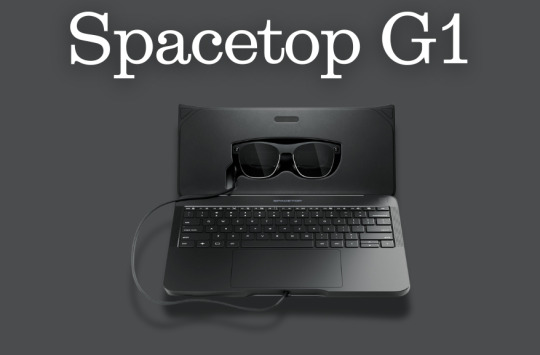
A laptop that employs augmented reality glasses as a display was called the Spacetop G1 system, and it was shown to a thousand productivity pioneers by the tech firm Sightful last year.
The upgraded Gen 1 device removes the requirement for the user to stoop over a tiny screen when working remotely on a laptop by placing a 100-inch virtual display directly in their eyes.
In this blog, The TechRobot will showcase the World’s first AR laptop: Spacetop G1. So let us begin.
What is Spacetop G1?
Sightful’s Screenless Laptop, the Spacetop G1, combines a computer with comfortable, lightweight augmented reality glasses. Running on the device is SpaceOS, a spatial operating system with an emphasis on online operations intended for productivity.
The weight of the AR glasses is 85 grams, but the Vision Pro, depending on the Light Seal, weighs between 600 and 650 grams. The keyboard is bulkier compared to a MacBook Air or iPad Pro, measuring less than 12 inches in width and weighing three pounds.
Cost of AR Laptop
The Screenless Laptop, Spacetop G1 charges $1,700 and is just a keyboard with spectacles attached.
Spacetop G1 Specs
Spacetop G1, features a Qualcomm Snapdragon QCS8550 CPU, Kryo GPU, Adreno 740 AI, dual eNPU V3, 48 INT8, 12 FP16 TOPs, 16 GB LPDDR5, 128 GB UFS3.1 storage, and 8-hour battery life.
They have two OLED display screens, a 50° field of vision, a 90Hz refresh rate, and very crisp text rendering.
The glasses enable Wi-Fi, Bluetooth, 5G, and a 5MP camera. They also contain a microphone for use in online meetings.
Benefits of AR Laptops
1. Endless View
With Spacetop’s Virtual Desktop, you may get amusement and information without having to navigate around, making it a convenient substitute for real screen space. Although it’s not the only solution with this functionality, this one could be the easiest to use.
A standard keyboard and touchpad, Spacetop’s AR glasses, and a perhaps lower price tag might allow customers to enjoy endless screen areas without sacrificing functionality. For individuals who would rather have a more ordered workstation, this would be a time-saving alternative.
2. Absolute privacy
Multi-monitor laptop attachments should not be used in public areas due to the increased danger of uninvited eyes peeping at private information caused by an excessive number of physical displays. Although privacy screens are available on certain computers and monitors, they are limited to one monitor.
To solve this, Spacetop is a Screenless Laptop, letting the user see their screen alone until it is shared with others. But it also means that those standing close to the user can’t see the screen without their glasses.
3. Improved posture
Laptops’ screens are firmly attached to the keyboard, making them portable yet uncomfortable. Some people find relief from this neck pain by attaching a desktop monitor.
The screenless laptop, Spacetop, provides a more comfortable height and does away with the need for arms or ergonomic monitor supports. Due to this, laptops are a better choice for use at home or in the workplace.
4. Laser Focus
Spacetop G1 is an Augmented Reality (AR) device that reduces visual distractions so users can work productively and enjoy their free time. The apps it may utilize, including Windows or macOS-based software and limited gaming, are restricted by its Android-based operating system and mobile hardware.
Notwithstanding these drawbacks, Spacetop provides a more practical experience than a typical computer since it places all of the necessary components in front of and surrounding users. Instead of letting others decide for them, users may choose whether to allow virtual distractions to affect them.
Highlight – Introducing Travel Mode For Meta Quest Headsets
Best AR Glasses for Laptops
1. Apple AR Glasses
Apple plans to develop AR glasses that look like conventional spectacles with a built-in display. A prototype of the glasses has a thick, attractive frame and resembles high-end luxury sunglasses. With references to Project Starboard and reports of a glassOS, the prototype is anticipated to function on iOS 14.
Though it could take a few more years for a public release, rumors indicate that Apple has already started the second phase of development. The glasses will have the ability to add prescription lenses, gesture-controlled instructions that connect with the Apple Watch, and a true vision display on both lenses.
Possible capabilities include the ability to use virtual things in real-world settings, do activities without using a phone, and enable immersive phone conversations and remote collaboration software.
2. Meta Glasses
Rebranding Facebook to Meta, Mark Zuckerberg is concentrating on augmented reality glasses and headsets. The business plans to deliver Meta spectacles, a prototype of their augmented reality spectacles, in late 2024. The Project Nazare and Project Aria prototypes provide a fully functional augmented reality experience, with 3D visuals and an elegant design. It is anticipated that the Meta Glasses will include an immersive experience with radio, speakers, and cameras, a holographic display with built-in projectors, batteries, and sensors, and a broad field of vision. In 2024, the prototype is anticipated to be released.
3. Xreal Air 2 Ultra
The Air 2 Ultra glasses from Xreal are an improvement over the Air 2 model and are aimed at competing with Apple’s Vision Pro and Meta’s Quest 3 headsets. Complete positional tracking, a form factor akin to eyeglasses, and compatibility for immersive AR apps, TV viewing, and flat-screen gaming are all features of the Air 2 Ultra.
It has a 52-degree field of vision, 500 nits of brightness, two cameras for environmental mapping, hand tracking, and compatibility with Xreal’s Nebula AR environment.
Is AR safe for your eyes?
Prolonged use of AR might result in headaches, nausea, and straining of the eyes. This is a result of our eyes continually focusing on objects at different distances when using AR. This can cause pain and eye tiredness.
Conclusion
The future of laptops with AR like the Spacetop G1 marks a breakthrough in laptop technology by utilizing augmented reality to provide a 100-inch virtual display that improves user posture, productivity, and privacy.
The Spacetop G1 presents a new option for remote work by addressing typical ergonomic concerns associated with standard laptops by mixing AR glasses with a powerful computing machine and the SpaceOS operating system.
Despite several drawbacks associated with its Android-based operating system and the possibility of eye discomfort after extended usage, the Spacetop G1 breaks new ground in augmented reality technology by offering consumers a more useful and engaging experience.
#spacetop1#ar#vr#ar glasses#laptop#virtual reality#augmented reality#mark zuckerberg#elon musk#meta ai#facebook
6 notes
·
View notes
Text
How Mobile App Development Companies Optimize for Emerging Devices
In today’s fast-paced digital world, technology evolves at breakneck speed.
With the rise of emerging devices such as foldable smartphones, wearable tech, AR/VR headsets, and IoT-enabled gadgets, mobile app development companies are under pressure to stay ahead of the curve. To ensure seamless user experiences across all these devices, developers must adapt, innovate, and optimize. But how exactly do they do it?
In this blog, we’ll explore how leading mobile app development companies optimize apps for emerging devices and why staying current is essential for business success.
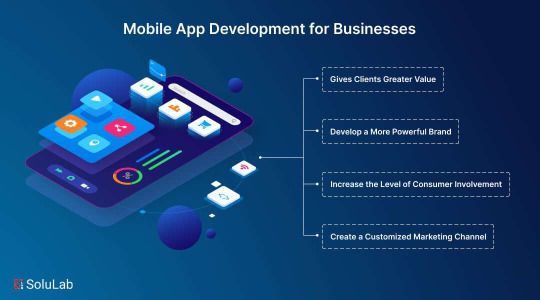
Understanding Emerging Devices
Emerging devices refer to the next-generation tech products that offer new functionalities and user experiences. These include:
Foldable smartphones (like Samsung Galaxy Z Fold)
Wearables (smartwatches, fitness trackers)
AR/VR headsets (like Meta Quest, Apple Vision Pro)
Voice-controlled assistants (like Amazon Echo, Google Nest)
IoT devices (smart home gadgets, connected appliances)
As these devices gain popularity, app developers must ensure compatibility, performance, and usability across this broadening ecosystem.
Cross-Platform Development is Key
One of the first steps mobile app development companies take to optimize for new devices is adopting cross-platform development frameworks like Flutter, React Native, and Xamarin. These tools allow developers to write a single codebase that can run on multiple platforms, including smartphones, tablets, and wearable devices.
Benefits of Cross-Platform Development:
Faster time to market
Cost-efficiency
Unified user experience
Easier maintenance and updates
By leveraging cross-platform development, companies can more easily adapt their apps to fit new screen sizes, hardware capabilities, and operating systems.
Responsive and Adaptive Design
Foldable phones and varying screen sizes bring a whole new level of complexity. Developers must implement responsive and adaptive design principles to ensure that the user interface adjusts seamlessly to different device layouts.
Optimization Techniques Include:
Flexible UI layouts that rearrange dynamically
Scalable vector graphics instead of fixed-size images
Viewport meta tags for proper scaling
Media queries to handle device-specific CSS
This ensures that whether an app is used on a compact smartwatch or a dual-screen foldable phone, it provides an intuitive and visually pleasing experience.
Leveraging Device-Specific Features
To truly optimize for emerging devices, mobile app development companies go beyond compatibility and start harnessing the unique features each device offers.
For example:
Smartwatches: Developers create lightweight apps with glanceable information and gesture controls.
AR/VR devices: They integrate spatial computing, motion tracking, and 3D rendering for immersive experiences.
Foldable phones: They use multi-window modes and app continuity features to transition seamlessly between folded and unfolded states.
Voice assistants: They build voice-enabled interfaces and natural language processing features to enhance hands-free usage.
By incorporating device-specific functionalities, apps not only run smoothly but also stand out in terms of innovation and user engagement.
Testing on Real Devices and Emulators
A key part of optimization is rigorous testing. Mobile app development companies use a combination of real device testing and emulator-based testing to ensure apps function correctly on every possible device configuration.
Testing includes:
UI/UX validation across screen sizes
Performance and memory usage analysis
Battery and network efficiency checks
Crash and error logging
By proactively testing for bugs and compatibility issues, developers can launch polished apps that provide a consistent experience across all platforms.
Keeping Up with OS and SDK Updates
Emerging devices often run on the latest versions of Android, iOS, watchOS, or proprietary operating systems. Mobile app developers must stay updated with the latest SDKs (Software Development Kits) and API changes to fully utilize the device capabilities and maintain compatibility.
Timely updates also ensure:
Security patches are applied
Deprecated features are removed
New functionalities are incorporated
This continuous learning mindset helps developers future-proof their apps and remain competitive.
Using Cloud and Edge Computing
To optimize performance and reduce latency on emerging devices, many mobile app development companies now leverage cloud computing and edge computing.
With these technologies:
Heavy computations are offloaded to the cloud
Edge devices process data closer to the source, improving real-time responsiveness
App performance becomes smoother, especially for AR/VR and IoT apps
This approach is especially crucial for devices with limited processing power like wearables and smart sensors.
Security and Privacy Considerations
Emerging devices often collect sensitive user data. As such, developers must build apps with robust security and privacy protocols. Techniques include:
End-to-end encryption
Biometric authentication
Secure APIs and data storage
GDPR and HIPAA compliance
A focus on security builds trust and ensures regulatory compliance, which is vital as data breaches and cyber threats rise.
Final Thoughts
Optimizing mobile apps for emerging devices is no longer optional—it’s a necessity. As user expectations evolve, so must the strategies of Website Development Company. By embracing cross-platform frameworks, adaptive design, device-specific features, and modern tech like edge computing, developers can create future-ready apps that delight users and drive engagement.
Whether you're a startup looking to launch a new app or a business aiming to stay relevant, partnering with a forward-thinking mobile app development company is your key to success in the age of emerging devices.
0 notes
Text
On June 25, 2024, Play For Dream Technology, a Shanghai-based leader in spatial entertainment technology, made a significant leap forward by launching the world’s first Android-based spatial computer, Play for Dream MR, in Singapore. This launch marks the company’s first international expansion, with Singapore now serving as its Asia-Pacific marketing headquarters. The global event attracted key media representatives, investors, and stakeholders from across the region, highlighting Play For Dream’s ambitious vision to redefine spatial computing on a global scale. Read more
#spatial computer#andriod based#mr gaming#qualcomm#the leaders globe magazine#news#business news#leadership magazine#media house
1 note
·
View note
Text
On June 25, 2024, Play For Dream Technology, a Shanghai-based leader in spatial entertainment technology, made a significant leap forward by launching the world’s first Android-based spatial computer, Play for Dream MR, in Singapore. This launch marks the company’s first international expansion, with Singapore now serving as its Asia-Pacific marketing headquarters. The global event attracted key media representatives, investors, and stakeholders from across the region, highlighting Play For Dream’s ambitious vision to redefine spatial computing on a global scale. Read more
0 notes
Text
On June 25, 2024, Play For Dream Technology, a Shanghai-based leader in spatial entertainment technology, made a significant leap forward by launching the world’s first Android-based spatial computer, Play for Dream MR, in Singapore. This launch marks the company’s first international expansion, with Singapore now serving as its Asia-Pacific marketing headquarters. The global event attracted key media representatives, investors, and stakeholders from across the region, highlighting Play For Dream’s ambitious vision to redefine spatial computing on a global scale. Read more
0 notes
Text
LEARNBLR #2, Weekend-mode engaged
New hexadecimal number system based around Latin/Cyrrilic/Greek letters so around (A,B,C,D,E,F,K,M,S,T,U,V,W,X,Y,Z)
'Argentique'
12x12 pixel cells & ~12x12 cells grid
MINIX3
TIS-100 low-power as low as possible tech-level requirements
Microsoft BOB's Chaos as virtual assistant analogy
SVG
Free and Open Source Software community
Georgism
Syndicalism
Libertarianism
Nomad48 color palette
OpenPOWER
ITS
CTSS
Multics
IPL
Tumblr 'WIN3D' theme custom overhaul
HyperCard/HyperTalk
Hypermedia with static HTML/CSS pages
Analog and home video rental store analogies
Lisp family structural and symbolic meta-programming similarities
Swift programming language
Fish shell
ZealC easy low-level access, full transparency and in-line multimedia editing
Esolangs site's deque, mysticism and analogical turing tarpit assomptions
Wax cylinders -> 45rpm autoplay small-size vinyls -> large Laserdiscs -> middle-sized optical symbolic disks
Cassettes -> Datasettes -> MiniDiscs -> SD cards
JVM & bytecode compiler/interpreter
Minitel, Prestel, Alex & Bulletin Board Systems, SAM Coupe, Armstrad CPC, Commodore 64, CBM II, SEGA Computer 3000,
Ural computer, MIR-1, MIR-2, russian ALGOL variants, Akademset, OGAS, Soviet Electronic Data Processing, Soviet Unit Record Equipment, BK-0010, AGAT, Law on Cooperatives, Runet, Yandex, OK, VK, EVM, SM EVM, Robotron, Hungarians' TPA, fifth generation computers initative up to 2010 from Japan & Bulgaria, Didaktik, Z9001, K-202, Galaksija, Rapira, Superplan, ALGOL68 with ALGOL W elements, Karel, SAKO, AGAT Schoolgirl's Robic, Perl, Rak...
NOOR, Teuton, BASICOIS, Smalltalk, Lusus, LOGO, FOCAL, Scratch, UTF-8,
Digital Equipment Corporation's COS-310, DIBOL, DECmate III(+?) & OpenVMS
Sun Microsystems' Voyager & misc. hardware
Konrad Zuse's KG
Wolfenstein The New Order's Pflaumen brand, Arya and Tekla
Computer job ladies from all times in history
Microsoft F# & F*
OpenXanadu project
Xerox Alto
SEGA Dreamcast hardware first edition
Olivetti Programma 101
Elektronika MK-52
Transmuters from Atari
PLATO V system's TUTOR language
Pixar early CGI renders
Pouet.net and all the demoscene world
Keypad-based I/O controls?
Cyberware augmentations?
First Tier aka playable Civs: Shoshones, Morocco, Assyrians as Inuits, Mayas Civ, Portugal, Polynesia...
Second Tier aka non-playable Civs: Poland, Songhay, Persia, Carthage, Ethiopia, Indonesia, Sweden, Iroquois as Hurons, Austria, Brazil, Incas, Ottomans, Netherlands, Venice.
City-States: [to be written]
Barbarians, Rebels, Observers and more: [to be written]
Constructed world considerations such as 12-bit tribbles as smallest data unit, multilingual coding paradigm, alternate history of media formats, 16^3 (so 3 elements of 16 unique possible sub-glyph each) ideogrammic dictionary, synthetic android machines of the Stellaris' Rogue Servitor vibe, no Wilsonism or at least way less of such, electricity cars are way ahead, harmonious collaboration on technologies, more variety in ways of thinking aka spirituality and rationalism coexist better, Panian grammars strongly credited link to Turing+Church thesis, less spatial exploration, even less extroverts success compared to introverts, smaller world, more isolation in between social spheres so less harmonious as of the last few decades, less biological matters understanding, medical technologies somewhat behind by two decades, cross-dimensional idiosyncratic imports, synthetic developments ahead by ~20-40 years, free high education similar to Soviet Union / Russia's, much wild-west style software piracy space on the sidelines, many super advanced free software resources to levels like Habrahabr and beyond, synthetic service grids outpacing human agencies' controls yet keeping a neutral attitude towards humans, many disperate computer networks instead of the world wide web we know, lesser adoption of such hyperTech by the laymen as non-enthusiasts went back to some sort of early 20th century-style primitivisms, some sort of aesthetic subculture tribe diversification developments growing real strong as of the last two decades, earlier global pandemic around 1996-2000, advanced nuclear energy abundance, more cross-national collaboration + harmony, sapient-kinds inclusivity as early as the last century or the last half-millenia, longer historical record going back more than ~2000 further into their past (so like 3000 BC instead of 1000 BC here)...
So I want to make a general-purpose (if I had to choose one topic, it would be to describe symbolic computation ala 'TuringTarpit' around video rental store deque operations) programming language 'Servitor' with specific analogical media and low-tech [any medieval scroll vellum media included] constraints in mind.
4 notes
·
View notes
Text
What Do Player Pianos, IBM Punchcards, Telepathy and Elon Musk’s Neuralink Have In Common?
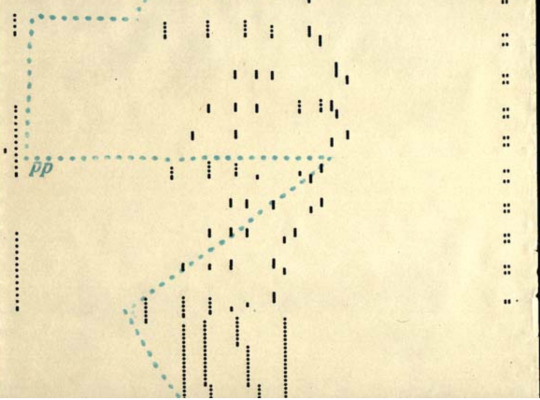
This is a player piano punch sheet or score taken from a rolled up drum. The holes make the keys move. It is a very simple pattern that translates into musical notes.

This is a decoding of “neural spikes” according to scientists at Elon Musk’s brain computer company Neuralink. The spikes are pictured in single boxes, and many spikes when they fire make a pattern. From that pattern you can begin to decode thought. According to Neuralink, “Everything you hear or think is all action potentials, its action spikes and it feels so real, it feels very real.”
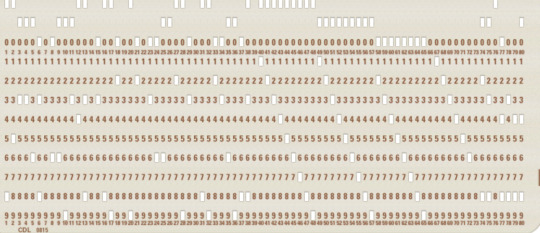
This is an early IBM computer punch card, and the basic pattern recognition of the presence or absence of holes in predefined patterns led to everything we know today about computers. Though IBM introduced the first cards in 1928, they had already been in use to ‘program’ cloth in the Jacquard loom in 1804, making gorgeous silks and tapestries.

I think we are basically back in the same position as we were when IBM first made the computer punch card in 1928 in terms of brain research and decoding thought. Neuralink is putting together elements in brain research that 100 years from now, or even 50 years from now will have tremendous repercussions. The company did not invent all of the aspects of technology it is using to put things together, but they did improve upon existing tech and brought it all together.
THE SURGICAL ROBOT

The Neuralink robot doing an implantation
Neuralink works by extracting electrical signals from neurons. In order to do that it has to implant extremely thin wires in the brain to access and read those signals onto a nanochip. Before it can do that, it has to make a precision surgical robot machine operated by neuroscientists to insert the wires - so it did. Apparently there was some DARPA money thrown into the mix somewhere along the way. The robotic surgeon has to implant tiny wires in between blood vessels and neurons, not on them. This can only be achieved through microscopes and nanometer precision. The implant needle is 24 microns small. Tiny threads are about 1/10 of a human hair, which is about the same size as a neuron. The needle to implant the wire is 24 microns small. You can open the skull, insert the threads, put in a tiny chip, and then glue the skull shut. The chip functions as a wireless bluetooth signal.
THE WIRES
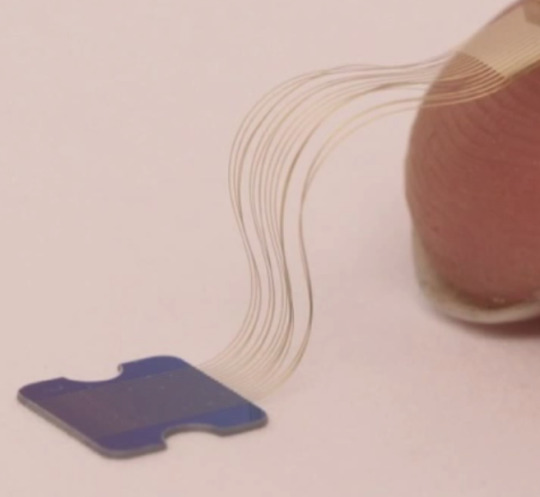
This picture shows thin nano threads pasted onto a fingertip. The thinness of this wire is the big issue DARPA was trying to solve with Moldavian wire from Paradromics, that I previously blogged about in 2017, but Musk beat them to the punch. He wrote about his breakthroughs here.
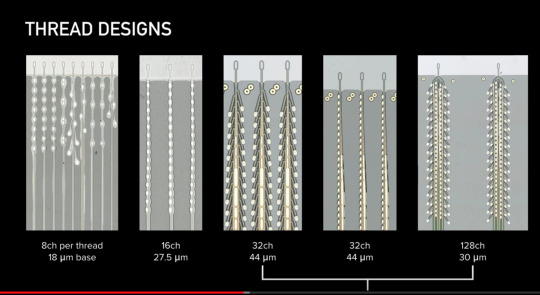
This is the different new design of the threads called a “linear edge”, which are made of layered polymers. They are so are super duper thin they can’t bee seen with a human eye, so they need the special robot that inserts the threads onto the surface of the brain. Another reason is the brain’s surface moves with inhalation and exhalation, and the robot can account for this natural movement. The wires and chip have to record the output from neurons. They are micro fabricated as precisely as the size of an electron beam. It is important to separate the signal to noise ratio in the chips, as they work with nanometer sizes of light. A new design. 350 nanometers,is smaller than visible light.

This image is the crux of how Neuralink acquires the signal. Here you see the neuron sending out an electrical spike and a thread next to it picking up the impulse. The electrical spike is the bulls eye. The copper colored needle is actually the implanted wire thread. You need to be 60 microns away or less to read the signals, so you really need to be under the skull. This is a graphic representation

This is a photo of the real thing, with lots of wires precision implanted into brain tissue. If you look really closely you will see they skirt around the blood vessels and neuron branches, but don’t touch any of them. Its sort of like an amazing game of darts, but the goal is to miss the bull’s eye of the vessels.
HISTORY OF IMPLANT CHIPS
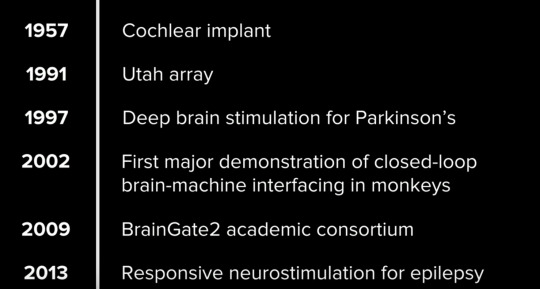
This is a short history of brain research about making chips to implant in the brain. At this point the Utah array is still the most used implant chip in academia. Neuralinks chips are way, way faster and smaller. Their research builds on a century of neuroscience research and a decade of neuro engineering research. More advanced applications with advanced innovations will follow.
CHIPS AND PODS
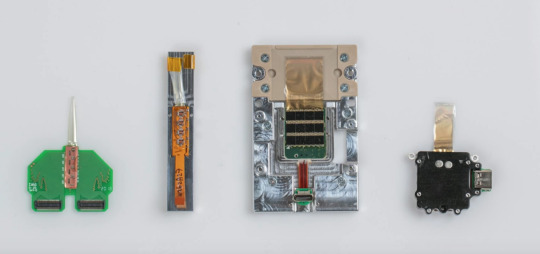
These are early iterations of chips and devices made by Neurlink. Looks like Arduino 101, more or less.

The N1 sensor - the beginning of the sophisticated bean sized implant that goes into the skull and contains the chips.
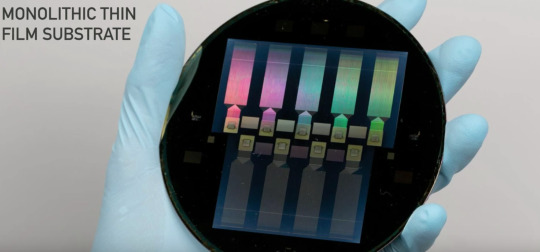
The actual chips are made on super thin nano wafers in a hermetic environment so there is no dust. They are also super duper thin. A 4 x 4 millimeter chip has a thousand electrodes,and implanting up to 10 chips is feasible. At this point the best FDA approved chip implant for Parkinsons Disease only has 10 electrodes. The Neuralink chips read and write, and are 1000 times more powerful than what is publicly approved. They will get better with newer versions.

Shades of Cyborg Neil Harbisson and his Eyeborg! The Neuralink implant with four chips receive information from the threads, and sends them to an output area for batteries and firmware.

This is the size of the output piece, like an earphone.You can upgrade the firmware on the pod on the ear, it is not the actual implant but connects to it. It will be controlled through an iPhone app. Probably Android as well.
SIGNAL PROCESSING

Waves of neural spikes from an array from implanted threads that are being read out on a computer. monitor The color screen shows the brain at work, and traces of electrodes from single threads. Each trace is a voltage waveform in time. If you focus on one trace, it shows voltage deflections, or spikes per wave. It occurs when a neuron has an action potential, because that is the core information that is recorded. Then the algorithm is decoded, which means capturing the intended information. You just have to think about something and build up the decoding data from that information or thought, and you can begin to interpret movement, memory, and many other different types of experiences.
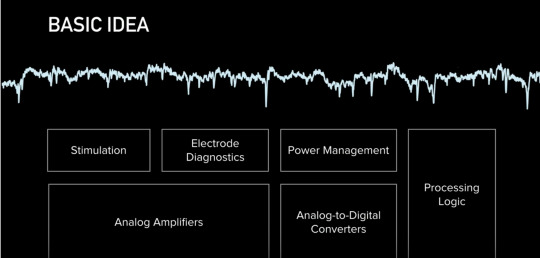
This is a basic diagram of signal processing from the chip - how they get the stuff out of the wires and threads to actually show the spikes. Neuralink said “Everything we care about is contained in the statistics of spikes (inside the brain).” So it goes back to the basic IBM punchcards, or the player piano drum roll - decipher the pattern and you decipher the thought.

Here is their basic logic analogue to digital conversion that is necessary to change action potential spikes to computer code..Calling Alvin Lucier, John Cage, Nam June Paik, David Rosenboom, Richard Teitelbaum - or Duh, this has been going on with the brain, changing analog to digital since 1965 in the music world.

Spike rasters in the brain - The top is the brainwave spikes pointed at by the blue arrows, and the bottom is the beginning of pattern recognition of individual neurons. There should be one pixel per electrode. They are on-chip spike detectors. The methods for detection are thresholding signals or directly characterizing the shape. The Neuralink scientists claim they can identify different neurons from same electrode based on their shape. The engineers had to modify the algorithms and scale them to compress neural data up to 200 times. It takes only 900 nano seconds to compute the signal, faster than the brain knows that the signal even occurred. They can also stimulate any combination of up to 64 channels

One good use of this in the next few years is creating visual feedback for the blind by targeting the visual cortex to create an image better than a dot matrix image - or computer vision basics meets brain wetware. The scientists want to not only read out, but read into the brain. You can read into the brain by passing a current in the electrode. This causes the cell to fire an action potential, like for cochlear implants, or a way for the eye to restore vision. You can also use this technique in the brain to restore the sense of touch or vision. The visual cortex has maps, a spatial map (orange section of the brain in graphic). If you stimulate a point in that area, a blind person sees a point of light or phosphene. The idea is you can stimulate areas of the brain in the visual cortex to resemble a dot matrix level of the world. There are also parts of the brain that control orientation, color, size and speed of moving objects, and once you figure out what they are, and where to stimulate them, you can generate a more comprehensive image that a blind person can experience. Neuralink wants a device with electrodes that are small enough, but with high density that can do better than a dot matrix image.
The first iteration of their implant will have three different types that can go from a mobile device to a mouse or keyboard on a Bluetooth signal. Neuralink needs to get FDA approval. Right now they are working on patients with complete paralysis so it is for serious neurological needs, and idea is to make it really safe.
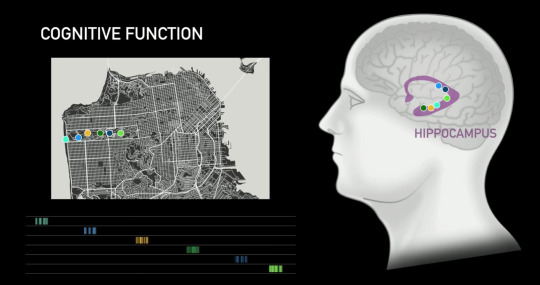
Who needs Google maps when you can tap into someone’s brain algorithm in their Hippocampus which contains spatial orientation. Here is a rendition of someone who really knows San Francisco, and they can send you pattern signals as you wander through the park and direct you telepathically - voila!
THE PURPOSE
Musk gave a number of reasons for his very public video presentation. The first he shamelessly admitted, was to recruit for new talent to Neuralink. He then framed the motivation of his company as wanting to solve brain ailments, spinal disorders, or catastrophic injuries like a broken neck or spine,. He admitted it won’t happen quickly, and kept mentioning the need for FDA approval. He wants to make his devices as cheap and accessible as a Lasik-like device.
“Hopefully,” he said, “AI is a benign scenario. You can chose to have a neural implant if you want, it is not a mandatory thing... We already have digital super intelligence - our access to a computer and a smart phone. The input speed in the human brain is fast, due to our vision, but the output speed is slow because we have to type information into a computer. We are constrained by human bandwidth and mechanics. “
But then he dropped the Neuralink AI bomb - that he believes that we “ultimately (will) achieve a symbiosis with artificial intelligence” (if you want it at a civilization level scale). Then he added, “two people with Neuralink could have telepathy, a new kind of communication, conceptual telepathy, it has to be consensual”.
So the new “me too” movement will concern having consensual telepathy #metooconsensualtelepathy.
*Screen shot photos all taken from publicly available Neuralink YouTube video here.
7 notes
·
View notes
Text
Netspot scan

#Netspot scan how to
#Netspot scan android
#Netspot scan software
#Netspot scan series
Will this scan be used preoperatively to define the extent of disease and alter decisions to operate? Will it replace cross-sectional imaging? Will increased detection of disease alter medical management and importantly, should it? All of these questions remain unanswered. As availability of 68Ga-DOTATATE PET/CT increases, it is believed that this imaging will become the gold standard, replacing octreotide scans for the evaluation of SSTR positive disease in patients with NETs.ĭespite the advances in SSTR functional imaging, it remains unclear how 68Ga-DOTATATE PET/CT will change our clinical practice. With FDA approval, there has been gradual increase in access to 68Ga-DOTATATE PET/CT in the United States, and this scan is now included in the NCCN guidelines as a form of SSTR based imaging. Food and Drug Administration (FDA) approved Netspot ™, the first kit for the preparation of 68Ga-DOTATATE injection for PET imaging, as a diagnostic tool to help clinicians determine the location and extent of NETs. 5– 12 Unlike octreotide scans, 68Ga imaging is a single-day procedure with higher spatial resolution, improved dosimetry, and the ability to semi-quantify the activity in a given region as the standard uptake value (SUV). In recent years, the development of novel functional imaging radioisotopes using PET tracers (the gallium-68 ( 68Ga) DOTA-peptides: 68Ga-DOTATOC, 68Ga-DOTATATE, 68Ga-DOTANOC) has demonstrated promising results for the visualization of NET lesions in comparison to conventional octreotide scans. 4 Given these findings, as indicated in the National Comprehensive Cancer Network (NCCN) guidelines, octreotide scans are not recommended for surveillance after resection, as an adjunct for tumor staging, or for monitoring the status of advanced disease. Although our report was controversial, a subsequent investigation evaluated the clinical utility of octreotide scans in the diagnosis and management of NET patients and also concluded that it did not alter surgical management. We advocated for the use of octreotide scans to test for the presence of the somatostatin receptor (SSTR) but not to follow the extent of disease. Based on our findings, we concluded that advances made in cross-sectional imaging changed the relative utility of octreotide scans. Octreotide scans, however, identified more asymptomatic and unsuspected bone metastases.
#Netspot scan series
3 In our institutional series of 121 patients, cross-sectional imaging detected more NET soft tissue lesions than octreotide scans. In 2011, our group evaluated the clinical utility of octreotide scans in detecting additional NET lesions as compared to conventional cross-sectional imaging. 1 While octreotide scans have the advantage of whole-body visualization, they also have limitations, including low spatial resolution, uptake of the radiotracer in normal organs, and increased burden on patients requiring multiple visits and scans over 2–3 days.
#Netspot scan how to
For more information on downloading NetSpot - WiFi Analyzer to your phone, check out our guide: how to install APK files.In 1994, the octreotide scan (somatostatin receptor scintigraphy with 111In-pentetreotide) was approved for imaging of neuroendocrine tumors (NETs) based on studies suggesting that octreotide scans were better at localizing and staging NETs when compared to conventional cross-sectional imaging (computed tomography (CT) and/or magnetic resonance imaging (MRI)). Furthermore, you may analyze a couple of real-time graphs to compare all Wi-Fi connections in your proximity and stop the scanning process at any time. In addition to all that, the application lets you sort networks by name or signal level. Moreover, users can filter items by the security protocol in case they intend to discover only WPS, WEP, or WPA-encrypted systems.
#Netspot scan android
The Android tool also shows a bunch of details about nearby networks, including their name (SSID), MAC address, frequency band, signal strength, and the number of channels. Therefore, it gives anyone the chance to check their current Wi-Fi connection, locate problems, and identify signal leakages. The mobile solution aims to be an optimal choice for all types of users, even if they have little knowledge of IT.
#Netspot scan software
Once tapped the play button in the top menu, the software starts a new scan and provides you with an easy-to-understand set of data. The app has an intuitive design and enables you to get valuable information about all surrounding Wi-Fi networks without a hitch.

0 notes
Text
What changes in the new iMac 2021?

It's not just more colors and a slimmer design, there's been a huge leap in performance. Check out everything that has improved in the new iMac 2021 over the past generation. After a decade in which the iMac maintained its external design, Apple decided to revolutionize. The new iMac 2021 brings countless cutting-edge technologies in an innovative design.
What changes in the new iMac 2021?
That the iMac needed a new face, we all knew. With more than a decade maintaining the same appearance, except for a small weight loss, in addition to 7 different colors, with two tones each. The available colors are blue, green, pink, silver, yellow, orange, and purple, and they will not be available in all versions. In the most basic model with 7-core GPU and standard keyboard "only" it will be available in blue, green, pink, and silver.

What changes in the new iMac 2021- the new iMac 2021 comes in a series of 7 color options The evolution of the iMac from 1998 to the present day has been accelerated. Now, the current model reveals a very beautiful 11.5 mm thick screen. It houses at the bottom all the equipment components, from the motherboard to the M1 chip, through the six speakers, camera, and microphones. This loudspeaker system is of high quality and features spatial sound, plus a set of studio-quality microphones for a rich multimedia experience and video calls Thus, the back is completely flat, resembling an iPad Pro. Supported by a stand, this new iMac 2021 is an achievement of Apple's engineering and design. 24 inch screen The new iMac debuts with a 24-inch screen. To be more precise, they are 23.5 inches with a resolution of 4,480 x 2,520 pixels, and a total of 11.3 million pixels. In other words, the screen offers a 4.5K resolution, slightly higher than the previous 21.5-inch model.
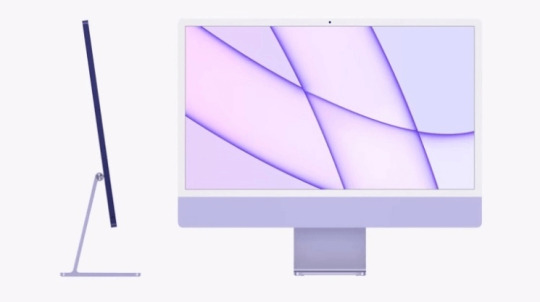
What changes in the new iMac 2021- iMac 2021 has a 24.5 inch screen In addition to True Tone technology, there are 500 nits of brightness and P3 color gamut, in addition to the significant reduction of three of the four frames around the screen. The size was kept at the bottom, but the apple logo disappeared. However, the logo is still on the back. In the upper frame, Apple integrated a webcam with 1080p resolution, integrated with an artificial intelligence system that significantly improves the quality of the image. This AI system analyzes and enhances each pixel to adjust important aspects such as white balance. As it could not be otherwise, Apple maintained its commitment to the environment from the first minute with the iMac 2021, a team that is made of recycled materials and dispenses with dangerous elements such as arsenic. New iMac with Apple Silicon M1 chip The Apple Silicon M1 chip has enough to break the usual restrictions of a conventional processor. Thanks to its new architecture, it is able to offer more power, more autonomy, and produce less heat on the MacBook Air and MacBook Pro M1. However, on desktop computers, there are no such restrictions, such as battery drain. But in them, the heat dissipation takes on another dimension. In the new iMac 2021, Apple used the same chip found in the most modern Macs and in the new iPad Pro. The agglutination and miniaturization of all components of this chip allowed a qualitative leap in design, while the performance is triggered and the heat is reduced.

What changes in the new iMac 2021 - The family of Apple computers with an M1 chip Thus, Apple achieved the following improvements over the previous generation iMac model: - CPU 85% more powerful than the previous generation. - GPU up to twice as powerful. - A series of machine learning applications up to three times greater. With the jump to the Apple M1 SoC, all the main components of the new iMac 2021 were integrated into a single logic board, which greatly reduced the space required and the required cooling solution. Looking at the current and the previous models, we can see how big this jump was. put USB There is a small division in the ports between different models of the new iMac 2021. The base model includes two USB Type-C ports with support for Thunderbolt 3, and the step-up model adds two USB-C ports (these two without support for Thunderbolt), along with an Ethernet compatible power adapter. Unlike recent iPhones, there is a headphone jack, but since the chassis is too thin to place it on the back, Apple has placed it on the left side of the display. The iMac 2020 had two USB-C ports and four traditional USB Type-A ports, an Ethernet port and an SD card slot, so there are some connectivity allowances for the new slim model. Apple probably expects it to be worth it, and that users have continued to switch to USB-C peripherals. The headphone connector on the older model was located at the rear, with the rest of the connections. Touch ID Touch ID comes to the iMac thanks to the new Magic Keyboard, which incorporates this function in one of its keys. This keyboard matches the color of the iMac, as well as the new Magic Mouse. External power supply The power supply is external, and apparently looks like a MacBook transformer, which not only saves space in the terminal body, but will allow for easier repairs of this element. The possibility of having a version of this unit with ethernet cable, another method of saving space in the body of the computer that Apple took out of its sleeve, stands out.
Technical specifications of the new iMacs (2021)
As always, there are minor changes to the settings year after year for iMacs. Check below the technical specifications according to the topology of each iMac (2021): 21.5 ″ (2020) / 24 ″ iMac (2021) - Input configuration ($1,299.00) - Processor: M1 with 8 cores - Graphics chip: M1 with 7 cores - Storage: 256GB with SSD slot - RAM: 8GB - Screen: Retina with 4.5K resolution - Connections: Two Thunderbolt / USB 4 ports - Accessories: Magic Keyboard 21.5 ″ (2020) / 24 ″ iMac (2021) - Intermediate Configuration ($1,499.00) - Processor: M1 with 8 cores - Graphics chip: M1 with 8 cores - Storage: 256GB with SSD slot - RAM: 8GB - Screen: Retina with 4.5K resolution - Connections: Two Thunderbolt / USB 4 ports, two USB 3 ports, and one-gigabit ethernet port - Accessories: Magic Keyboard with Touch ID 21.5 ″ (2020) / 24 ″ iMac (2021) - Top of the line configuration ($1,699.00) - Processor: M1 with 8 cores - Graphics chip: M1 with 8 cores - Storage: 512GB with SSD slot - RAM: 8GB - Screen: Retina with 4.5K resolution - Connections: Two Thunderbolt / USB 4 ports, two USB 3 ports, and one-gigabit ethernet port - Accessories: Magic Keyboard with Touch ID
Price, launch, and availability of the iMac 2021
During the Spring Loaded event on 20 April 2021 Apple announced that from Friday 30 April it will be possible to pre-order the 24in iMac from Apple. ModelPrice 2021 24 ″ (2021) iMac config. input$1,299.0024 ″ (2021) iMac config. intermediate$1,499.0024 ″ (2021) iMac config. Top of the line$1,699.00the new iMac 2021 Last in NUpgrade - Best off-road GPS apps for android and ios IOS in 2021 - The best free antivirus for Windows in 2021 - How to recover deleted or corrupted files 2021 (Windows and Android) - UNPRECEDENTED! Images show that Mars has the largest canyon in the Solar System - How to create an ISO image on a USB stick for Windows and Linux? - The best Amazon selling games in the UK and USA 2020 - A new version of Instagram for children under 13 ?! Read the full article
0 notes